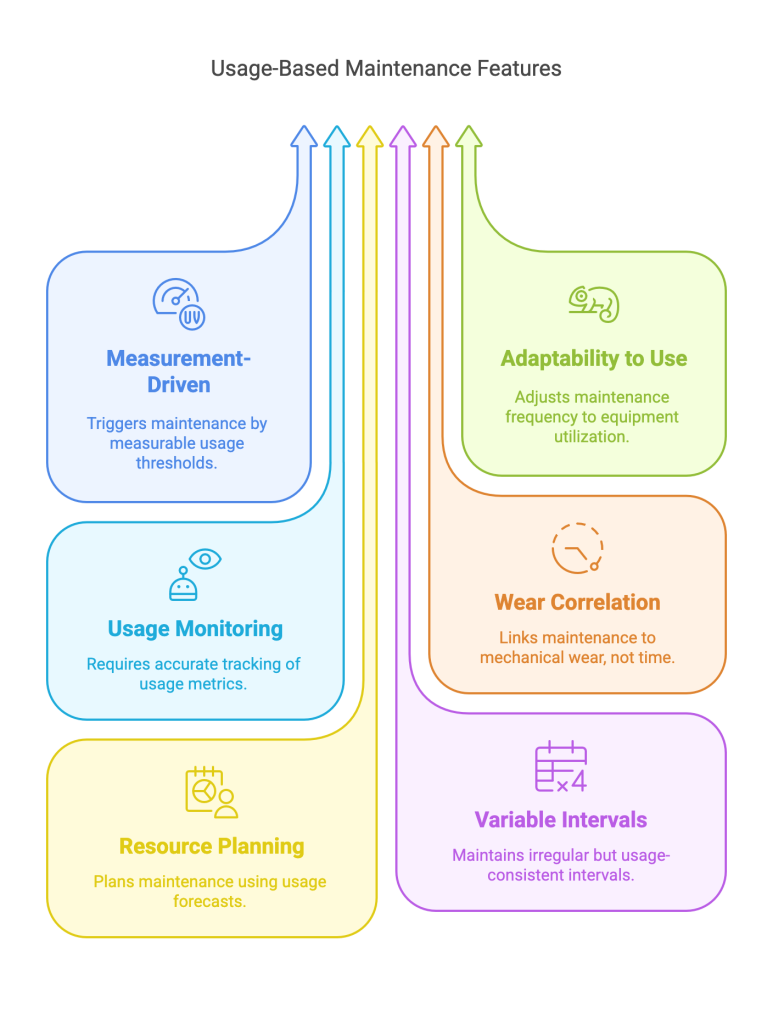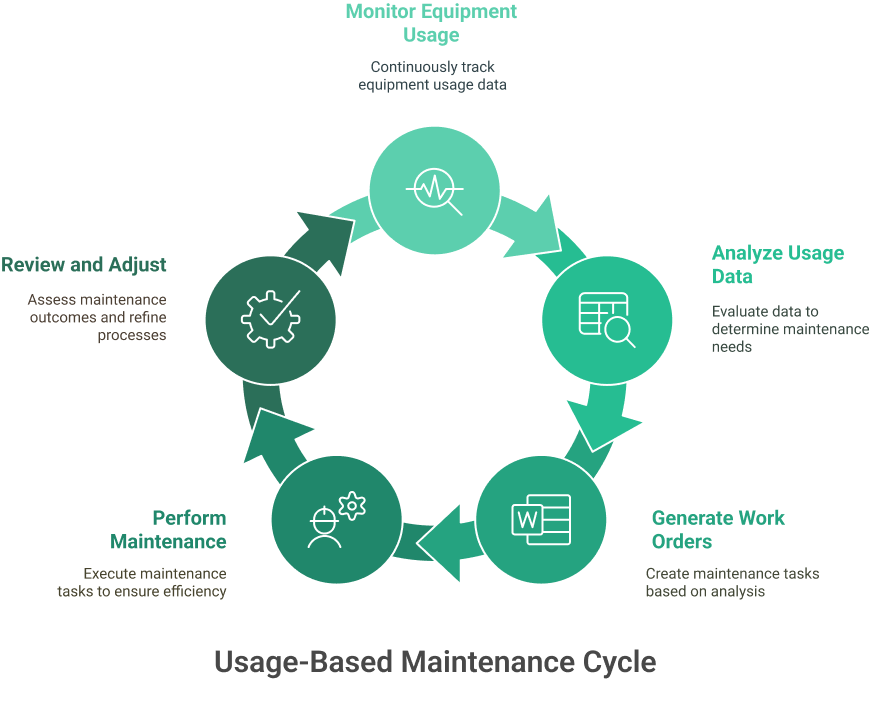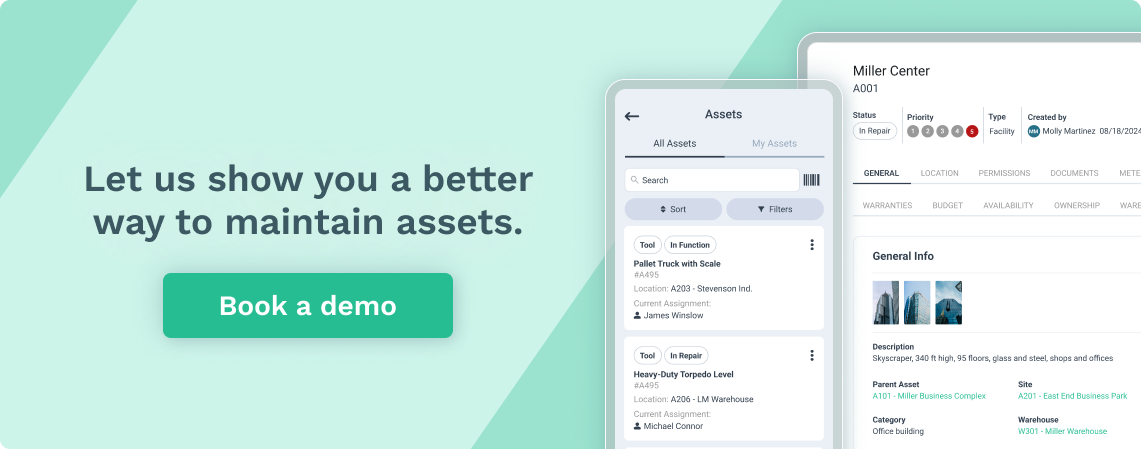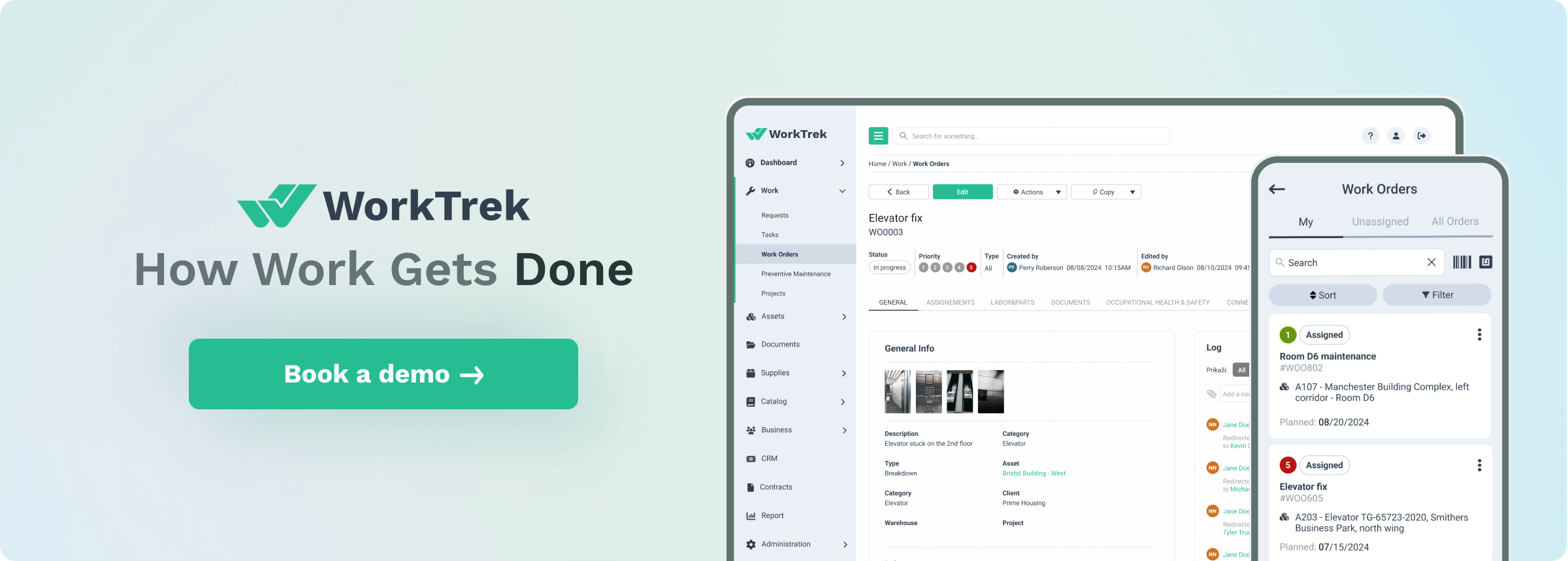What is Usage-Based Maintenance (UBM)?
Usage-based maintenance is a preventive maintenance strategy that schedules maintenance activities based on the actual utilization of equipment rather than calendar time.
This approach relies on quantifiable usage metrics—such as operating hours, production cycles, mileage, production volume, or the number of operations performed—to trigger maintenance interventions.
Unlike calendar-based maintenance, which schedules activities according to elapsed time regardless of equipment use, usage-based maintenance directly correlates maintenance timing with how intensively the equipment has been used.
This creates a more logical relationship between wear and maintenance, as equipment typically deteriorates in proportion to usage rather than the simple passage of time.
Maintaining equipment is crucial for ensuring business continuity and operational efficiency. Proactive maintenance helps prevent unexpected failures and extends equipment lifespan.
Definition and Functionality
Usage-Based Maintenance (UBM) is a proactive preventive maintenance strategy that tailors maintenance activities based on actual equipment usage rather than a fixed schedule.
This approach ensures that maintenance occurs only when necessary, based on actual wear and tear, reducing the risk of over-maintenance or under-maintenance. UBM relies on key attributes and data such as usage patterns, performance metrics, and maintenance history to trigger maintenance activities.
Using a Computerized Maintenance Management System (CMMS) allows maintenance managers to track and manage usage-based maintenance effectively, optimizing maintenance resources and reducing downtime.
Key Characteristics of Usage-Based Maintenance:
Several defining features distinguish usage-based maintenance:
- Measurement-Driven: Maintenance is triggered by reaching specific, measurable usage thresholds rather than calendar dates.
- Adaptability to Operational Intensity: Maintenance frequency naturally adjusts to match actual equipment utilization—more intensive use leads to more frequent maintenance, while idle periods don’t unnecessarily trigger maintenance.
- Usage Monitoring Requirements: Requires systems to track accurately and record equipment usage metrics.
- Correlation with Wear Mechanisms: Based on the principle that mechanical wear and degradation are more closely linked to usage than to calendar time.
- Predictable Resource Planning: Enables maintenance planning based on projected usage rates and equipment utilization forecasts.
- Variable Maintenance Intervals: Creates maintenance intervals that may be irregular in calendar time but consistent in equipment usage.

Source: Worktrek.com
Types of Usage-Based Maintenance:
Usage-based maintenance encompasses several specific approaches based on the type of usage metric employed:
- Hour-Based Maintenance: Scheduled according to operating hours or runtime (e.g., maintenance every 1,000 hours of operation for generators or engines).
- Cycle-Based Maintenance: Triggered by the number of cycles or operations performed (e.g., maintenance after 10,000 press cycles for a stamping machine).
- Production-Based Maintenance: Based on production volume or throughput (e.g., maintenance after processing 50,000 tons of material).
- Distance-Based Maintenance: Scheduled according to distance traveled (e.g., vehicle maintenance every 5,000 miles).
- Start/Stop-Based Maintenance: Triggered by the number of start-up and shutdown sequences, which can cause significant wear (e.g., maintenance after 500 starts for a turbine).
- Energy Consumption-Based Maintenance: Scheduled based on energy consumed (e.g., maintenance after 1,000,000 kWh for specific electrical equipment).
Comparison with Other Maintenance Strategies:
To better understand usage-based maintenance, it’s helpful to compare it with other common maintenance approaches:
- Vs. Calendar-Based Maintenance: Usage-based maintenance adapts to actual equipment utilization, while calendar-based maintenance occurs at fixed intervals regardless of usage.
- Vs. Condition-Based Maintenance: Usage-based maintenance triggers activities at predetermined usage thresholds, whereas condition-based maintenance relies on monitoring the actual condition of equipment to determine when maintenance is needed.
- Vs. Reactive Maintenance: Usage-based maintenance is preventive and performed before failure occurs, while reactive maintenance is performed after equipment has already failed.
- Vs. Predictive Maintenance: Usage-based maintenance uses more straightforward usage metrics than complex algorithms and multiple parameters analyzed in predictive maintenance.
Equipment Best Suited for Usage-Based Maintenance
Usage-based maintenance is not equally effective for all types of equipment. It is most appropriate for:
- Equipment with Usage-Related Wear Patterns: Assets where degradation is directly proportional to usage rather than calendar time (e.g., engines, pumps, conveyor systems).
- Equipment with Variable Usage Intensity: Assets that may be heavily used in some periods and lightly used or idle in others, making calendar-based schedules inefficient.
- Equipment with Built-in Usage Meters: Assets with integrated hour meters, cycle counters, or other usage tracking capabilities that provide reliable usage data.
- High-Value Mobile Equipment: Vehicles, construction equipment, and other mobile assets with significant maintenance costs and considerable usage.
- Production Equipment: Manufacturing machinery where wear is directly related to production volume or operating cycles.
- Equipment with Consumable Components: Systems with parts that have predictable lifespans measured in usage units (e.g., filters, belts, or bearings with established life expectancies in hours or cycles).
- Equipment with Established Usage-Based Maintenance Guidelines: Assets where manufacturers provide specific recommendations for maintenance based on usage metrics.
Examples of equipment well-suited for usage-based maintenance include:
- Vehicles and fleet equipment (maintenance based on mileage or engine hours)
- Aircraft (maintenance based on flight hours or cycles)
- Industrial engines and generators (maintenance based on operating hours)
- Production machinery (maintenance based on operating hours or production counts)
- Mining and construction equipment (maintenance based on operating hours or material processed)
- Printing presses (maintenance based on impression count)
- Elevators (maintenance based on number of trips)
- Pumps and compressors (maintenance based on running hours or cycles)
- CNC machines (maintenance based on operating hours or parts produced)
- Material handling equipment like forklifts (maintenance based on operating hours)
Industries That Benefit from Usage-Based Maintenance
Several industries can benefit from Usage-Based Maintenance, including:
- Fleet Management: Companies with large fleets of vehicles can use UBM to optimize maintenance scheduling based on actual vehicle usage, reducing waste and unnecessary expenses.
- Oil & Gas: Oil and natural gas producers can use meter-based PMs to track equipment usage, automatically generating work orders when the machine reaches a predetermined usage threshold.
- Facilities: Facilities managers can use UBM to maintain critical store equipment, avoiding misspent labor and parts.
- Manufacturing: Manufacturers can import meter reading measurements from critical equipment, automatically triggering priority work orders and inspections when values fall outside predefined parameters.

Benefits of Usage-Based Maintenance
Usage-Based Maintenance offers numerous benefits, including:
- Reduced waste and unnecessary expenses
- Increased maintenance of hard-working machinery
- Improved reliability
- Extended equipment lifespan
- Improved maintenance efficiency
- Reduced downtime
- Increased equipment productivity
- Reduced maintenance costs
- Extended life of assets
Increased Equipment Lifespan
Usage-based maintenance (UBM) helps extend the lifespan of equipment by ensuring that maintenance occurs only when necessary, based on actual wear and tear. By reducing excessive maintenance, UBM minimizes the risk of premature wear and tear, allowing equipment to operate for longer periods. Regular maintenance activities, such as servicing equipment based on actual usage, also help identify and address potential issues before they lead to equipment failure.

Improved Maintenance Efficiency
Usage-based maintenance improves maintenance efficiency by optimizing maintenance resources and reducing downtime.
Using a CMMS to track and manage usage-based maintenance, maintenance managers can prioritize maintenance activities based on actual equipment usage, reducing the risk of unexpected breakdowns. UBM also enables maintenance technicians to focus on servicing equipment that requires attention rather than performing unnecessary maintenance tasks.
Best Practices for Usage-Based Maintenance
Implementing an effective usage-based maintenance program requires thoughtful planning and disciplined execution. Here are the key best practices:
1. Establish Appropriate Usage Thresholds
The foundation of effective usage-based maintenance is setting the right usage thresholds for maintenance activities:
- Reference Manufacturer Guidelines: Begin with the OEM’s recommended maintenance intervals, which are typically based on extensive testing and failure analysis.
- Consider Operating Environment: Adjust standard intervals based on environmental conditions such as temperature extremes, dust, moisture, or corrosive atmospheres that might accelerate wear.
- Analyze Historical Data: Review equipment failure history to refine usage thresholds based on actual performance in your specific operating conditions.
- Incorporate Component-Specific Requirements: Different components within the same equipment may have different optimal maintenance intervals—develop a comprehensive approach that addresses all critical components.
- Balance Risk and Cost: More frequent maintenance reduces risk but increases costs; less frequent maintenance saves immediate costs but may increase failure risk and lifecycle costs.
- Implement Tiered Maintenance Structure: Create a hierarchy of maintenance activities at different usage thresholds (e.g., minor service at 250 hours, major service at 1,000 hours, overhaul at 5,000 hours).
2. Implement Reliable Usage Monitoring Systems
Accurate usage tracking is critical for usage-based maintenance:
- Install Appropriate Meters and Counters: Ensure all equipment has reliable mechanisms to measure relevant usage parameters (hour meters, cycle counters, production counters).
- Calibrate Measuring Devices: Regularly verify the measuring devices’ accuracy to ensure maintenance is triggered at the correct intervals.
- Automated Data Collection: When possible, implement automated systems to collect usage data rather than relying on manual recording.
- Redundant Monitoring: For critical equipment, consider redundant usage tracking methods to prevent missed maintenance due to meter failure.
- Regular Verification: Periodically verify recorded usage against other operational indicators to ensure accuracy.
- Tamper Prevention: Implement safeguards to prevent unauthorized resetting or tampering with usage meters that could disrupt maintenance scheduling.
3. Develop Comprehensive Maintenance Procedures
For each maintenance threshold, develop detailed procedures that:
- Provide Clear Task Instructions: Create step-by-step instructions for performing all maintenance activities at each usage threshold.
- Specify Required Resources: List all tools, parts, materials, and personnel skills needed for each maintenance activity.
- Include Inspection Points: Incorporate thorough inspection elements to identify potential issues before they become failures.
- Address Safety Requirements: Include lockout/tagout procedures, personal protective equipment requirements, and other safety precautions.
- Create Verification Methods: Establish clear criteria for verifying that maintenance was performed correctly.
- Document Reset Procedures: Include instructions for resetting maintenance counters or indicators after completion.
4. Implement Effective Planning and Maintenance Schedules
Planning is essential for efficient usage-based maintenance:
- Usage Forecasting: Analyze usage patterns and operational plans to forecast when equipment will reach maintenance thresholds.
- Maintenance Windows: Schedule maintenance activities to minimize operational disruption based on projected usage rates.
- Resource Allocation: Ensure the personnel, parts, and tools are available when equipment is projected to reach maintenance thresholds.
- Workflow Integration: Coordinate usage-based maintenance with operational schedules to minimize downtime.
- Scheduling Buffers: Build flexibility into maintenance scheduling to accommodate unexpected changes in equipment usage.
- Bundling Maintenance Activities: When multiple systems or components approach their maintenance thresholds at similar times, coordinate activities to minimize total downtime.
5. Manage Parts and Materials Effectively
Ensure timely availability of all needed maintenance materials:
- Inventory Based on Usage Rates: Maintain parts inventory levels based on projected usage rates and approaching maintenance thresholds.
- Critical Spares Management: Identify and maintain an adequate inventory of critical components that could cause significant downtime if not immediately available.
- Vendor Coordination: Establish relationships with suppliers to ensure the rapid availability of parts not kept in inventory.
- Kitting: Pre-assemble maintenance kits containing all parts and materials needed for specific usage-based maintenance activities.
- Quality Control: Implement procedures to verify the quality and authenticity of maintenance parts before installation.
- Obsolescence Management: Proactively address parts obsolescence issues for older equipment.
6. Document and Track Maintenance Activities
Comprehensive documentation supports continuous improvement:
- Usage History Records: Maintain detailed records of equipment usage over time to identify usage patterns and trends.
- Maintenance History: Document all maintenance activities, including the usage value at which maintenance was performed.
- Findings and Observations: Record equipment condition observations during maintenance to identify developing issues.
- Parts Replacement Data: Track component replacements to identify patterns in component lifespan.
- Deviations and Exceptions: Document deviations from standard maintenance procedures or schedules and their justifications.
- Digital Documentation: Utilize digital systems to ensure records are easily accessible, searchable, and analyzable.
7. Analyze and Optimize the Maintenance Program
Continuous improvement is essential for an effective usage-based maintenance program:
- Performance Analysis: Regularly analyze equipment performance data to assess the effectiveness of current maintenance thresholds.
- Failure Analysis: Conduct a thorough analysis of any failures to determine if adjustments to usage thresholds or procedures are needed.
- Cost-Benefit Analysis: Periodically evaluate the costs and benefits of the maintenance program to identify optimization opportunities.
- Benchmark Against Industry Standards: Compare your usage thresholds and practices with industry benchmarks and best practices.
- Technology Integration: Evaluate opportunities to incorporate new technologies such as IoT sensors, data analytics, or machine learning to enhance the program.
- Regular Program Review: Conduct comprehensive reviews of the maintenance program regularly to ensure continued effectiveness.
8. Train and Engage Personnel
The human element is critical to program success:
- Technical Training: Ensure maintenance personnel have the technical skills to perform maintenance tasks correctly.
- Program Understanding: Help all stakeholders understand the principles and benefits of usage-based maintenance.
- Operator Involvement: Train equipment operators to perform basic inspections and be alert for signs of developing issues between scheduled maintenance.
- Communication Protocols: Establish clear procedures for reporting usage milestones, scheduling maintenance, and communicating findings.
- Continuous Education: Provide ongoing training as equipment, procedures, and technologies evolve.
- Knowledge Management: Implement systems to capture and share expertise and lessons learned across the maintenance team.
Using a Computerized Maintenance Management System to Manage Usage-Based Maintenance
A Computerized Maintenance Management System (CMMS) like WorkTrek significantly enhances the implementation and management of usage-based maintenance. Here’s how a CMMS supports this maintenance strategy:
1. Usage Tracking and Threshold Management
A CMMS provides sophisticated tools for monitoring equipment usage and triggering maintenance:
- Meter Reading Management: Record and track equipment meter readings such as hours, cycles, miles, or production counts.
- Multiple Meter Types: Support various usage metrics for different equipment types within a single system.
- Automated Data Collection: Interface with equipment controllers, IoT sensors, or SCADA systems to automatically collect usage data without manual entry.
- Maintenance Triggers: Set usage thresholds that automatically generate work orders when reached.
- Graduated Maintenance Schedules: Configure multiple maintenance activities at different usage intervals (e.g., different tasks at 250, 500, and 1,000 hours).
- Meter Reading Validation: Implement validation rules to flag potentially erroneous meter readings that could disrupt maintenance scheduling.
- Multi-Parameter Triggering: Set maintenance triggers based on combinations of usage parameters (e.g., hours AND cycles, whichever comes first).
2. Forecasting and Planning
A CMMS enables proactive planning based on usage patterns:
- Usage Rate Calculation: Automatically calculate the rate at which equipment accumulates usage based on historical data.
- Maintenance Forecasting: Project when equipment will reach maintenance thresholds based on current usage rates.
- Resource Planning: Forecast labor, parts, and tool requirements based on approaching maintenance thresholds.
- Workload Balancing: Distribute maintenance activities to balance workload and prevent resource constraints.
- What-If Scenario Analysis: Model the impact of changes in equipment usage on maintenance scheduling and resource requirements.
- Long-Range Planning: Based on usage forecasts, project maintenance needs months or years in advance.
- Critical Path Analysis: Identify maintenance activities that could impact production schedules or project timelines.
3. Work Order Management
A CMMS streamlines the complete work order lifecycle for usage-based maintenance:
- Automated Work Order Generation: Create work orders automatically when usage thresholds are approached or reached.
- Task Templates: Develop comprehensive templates for recurring usage-based maintenance tasks.
- Mobile Access: Technicians should be able to receive work orders, record completions, and enter meter readings via mobile devices.
- Priority System: Assign priorities to maintenance tasks based on criticality and operational impact.
- Multi-Level Approvals: Implement approval workflows for completed maintenance to ensure quality control.
- Maintenance History: Maintain detailed records of all completed maintenance, including the usage value at which it was performed.
- Labor Tracking: Record time spent on maintenance tasks for performance analysis and future planning.
4. Inventory and Parts Management
A CMMS integrates parts management with usage-based maintenance:

- Usage-Based Inventory Forecasting: Project parts needs based on approaching maintenance thresholds.
- Automatic Parts Reservation: Reserve necessary parts for upcoming usage-based maintenance activities.
- Minimum Stock Levels: Maintain appropriate inventory levels based on usage rates and lead times.
- Parts Usage Tracking: Record parts consumed during maintenance activities for cost tracking and analysis.
- Vendor Management: Maintain vendor information and automate purchasing processes for maintenance parts.
- Kit Management: Create and manage maintenance kits containing all parts needed for specific usage-based maintenance activities.
- Parts Life Tracking: Monitor the lifespan of critical components to refine replacement intervals.
5. Data Analysis and Reporting
A CMMS enables sophisticated analysis to optimize maintenance programs:
- Usage Pattern Analysis: Identify patterns and trends in equipment usage to refine maintenance planning.
- Reliability Analysis: Correlate maintenance intervals with equipment reliability to optimize maintenance thresholds.
- Cost Analysis: Track and analyze maintenance costs at different usage intervals to identify the most cost-effective maintenance strategy.
- Compliance Reporting: Generate reports demonstrating adherence to required maintenance intervals for regulatory or warranty purposes.
- Performance Dashboards: Create visual representations of key performance indicators related to usage-based maintenance.
- Exception Reporting: Highlight overdue maintenance or unusual usage patterns requiring attention.
- Custom Report Generation: Create tailored reports for different stakeholders focusing on their specific areas of interest.
6. Integration with Other Systems
A CMMS can connect usage-based maintenance with other enterprise systems:
- Equipment Control Systems: Interface with PLCs, SCADA systems, or equipment controllers to gather usage data automatically.
- Fleet Management Systems: Integrate with telematics and GPS systems for vehicle maintenance.
- Enterprise Resource Planning (ERP): Connect with broader enterprise systems for coordinated resource planning.
- Production Planning Systems: Coordinate maintenance with production schedules to minimize operational impact.
- IoT Platforms: Interface with IoT sensors and platforms for real-time usage monitoring.
- Financial Systems: Link maintenance activities with financial tracking for accurate cost analysis.
- Document Management Systems: Connect with technical documentation and procedures for easy access during maintenance.
7. Implementation Best Practices for CMMS in Usage-Based Maintenance
To maximize the benefits of a CMMS for usage-based maintenance:
- Start with Accurate Equipment Data: Ensure all equipment information, including proper initial meter readings, is accurately entered into the system.
- Define Clear Maintenance Triggers: Establish unambiguous usage thresholds for triggering maintenance activities.
- Standardize Meter Types and Units: Create consistent naming conventions and units for usage metrics across similar equipment.
- Establish Reading Collection Procedures: Develop clear processes for collecting and entering usage readings, whether manual or automated.
- Implement Data Validation: Set up validation rules to identify potentially erroneous meter readings that could disrupt maintenance.
- Create Comprehensive Task Libraries: Develop detailed maintenance procedure libraries for different equipment types and usage thresholds.
- Provide Thorough Training: Ensure all maintenance resources understand how to use the CMMS properly for usage-based maintenance.
- Start Simple and Expand: Begin with basic usage tracking for critical equipment and gradually expand to a more comprehensive program.
- Regular System Audits: Periodically verify that the CMMS configuration matches actual equipment and operational needs.
8. Special Considerations for Usage-Based Maintenance in a CMMS
Usage-based maintenance presents some unique challenges in a CMMS:
- Non-Linear Meter Management: Configure the system to handle non-linear meters that may reset or roll over after reaching maximum values.
- Parent-Child Meter Relationships: Manage relationships between equipment with dependent usage metrics (e.g., a vehicle engine’s hours related to the vehicle’s mileage).
- Multiple Meter Management: Coordinate maintenance triggered by different usage parameters on the same equipment.
- Seasonal Usage Variations: Account for seasonal or operational variations in usage rates when forecasting maintenance.
- Meter Reading Frequency: Establish appropriate intervals for collecting usage readings based on usage rates and maintenance thresholds.
- Maintenance Window Management: Define acceptable ranges around usage thresholds where maintenance can be performed (e.g., ±5% of the target value).
- Historical Data Migration: Properly transfer usage and maintenance data when implementing a new CMMS.
9. Advanced CMMS Features for Usage-Based Maintenance
Modern computerized maintenance management system offers advanced capabilities that enhance usage-based maintenance:
- Predictive Analytics: Use historical data to predict equipment failures based on usage patterns and maintenance history.
- Machine Learning Algorithms: Automatically adjust maintenance thresholds based on actual equipment performance and failure data.
- Digital Twins: Create virtual models of physical assets that simulate performance under different usage and maintenance scenarios.
- Mobile Meter Reading Apps: Enable field personnel to record meter readings using mobile devices with validation features easily.
- Geospatial Integration: Incorporate location data for mobile equipment to optimize maintenance scheduling based on equipment proximity.
- Augmented Reality Support: Provide technicians with AR-enhanced maintenance instructions based on specific equipment and usage conditions.
- Benchmarking Tools: Compare maintenance intervals and effectiveness across similar equipment to identify best practices.
Organizations can transform a straightforward maintenance approach into a sophisticated, data-driven program by leveraging a CMMS to manage usage-based maintenance.
The CMMS provides the structure, automation, and analytics capabilities to ensure maintenance is performed at optimal intervals based on actual equipment usage, resources are used efficiently, and the maintenance program continuously improves based on performance data.
Get a Free WorkTrek Demo
Let's show you how WorkTrek can help you optimize your maintenance operation.
Try for free



